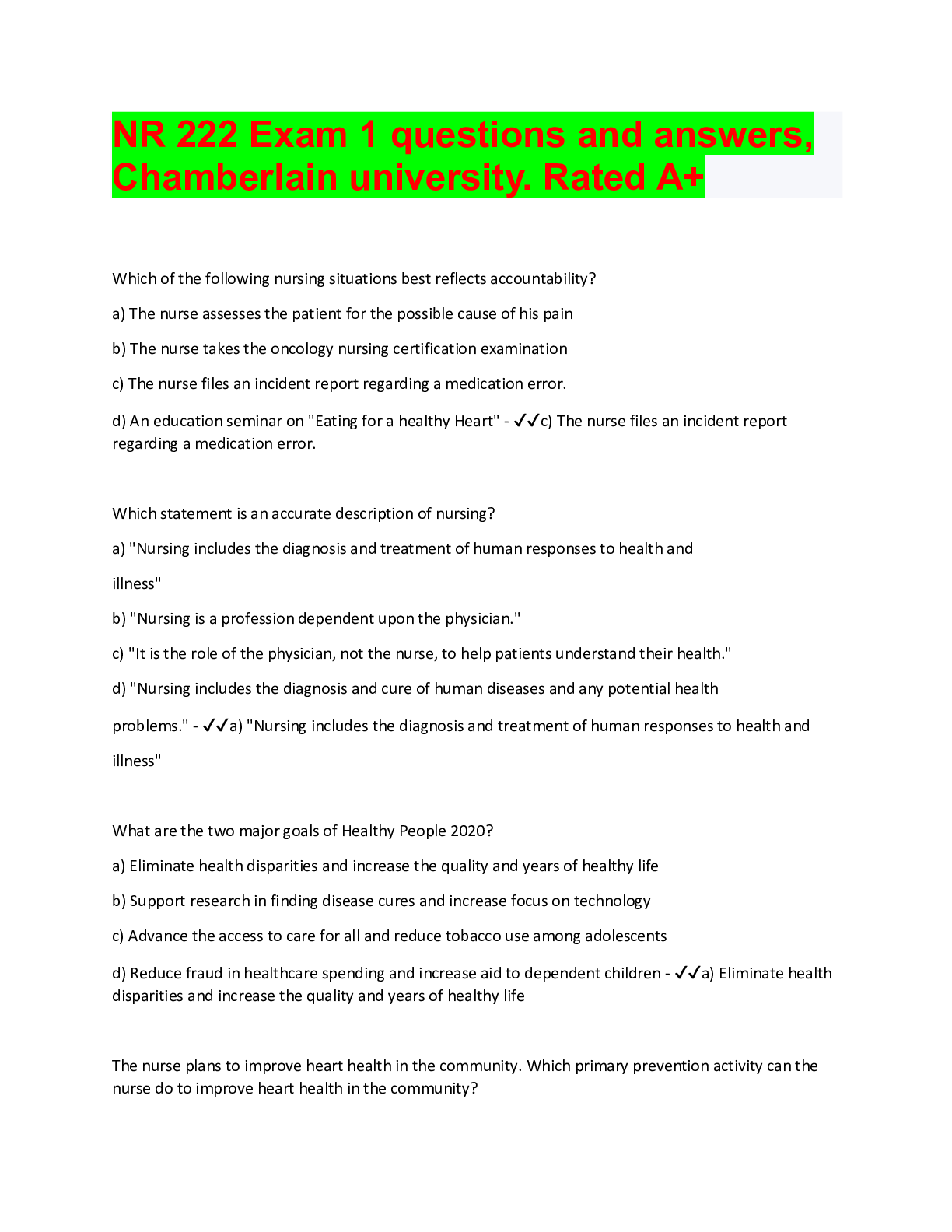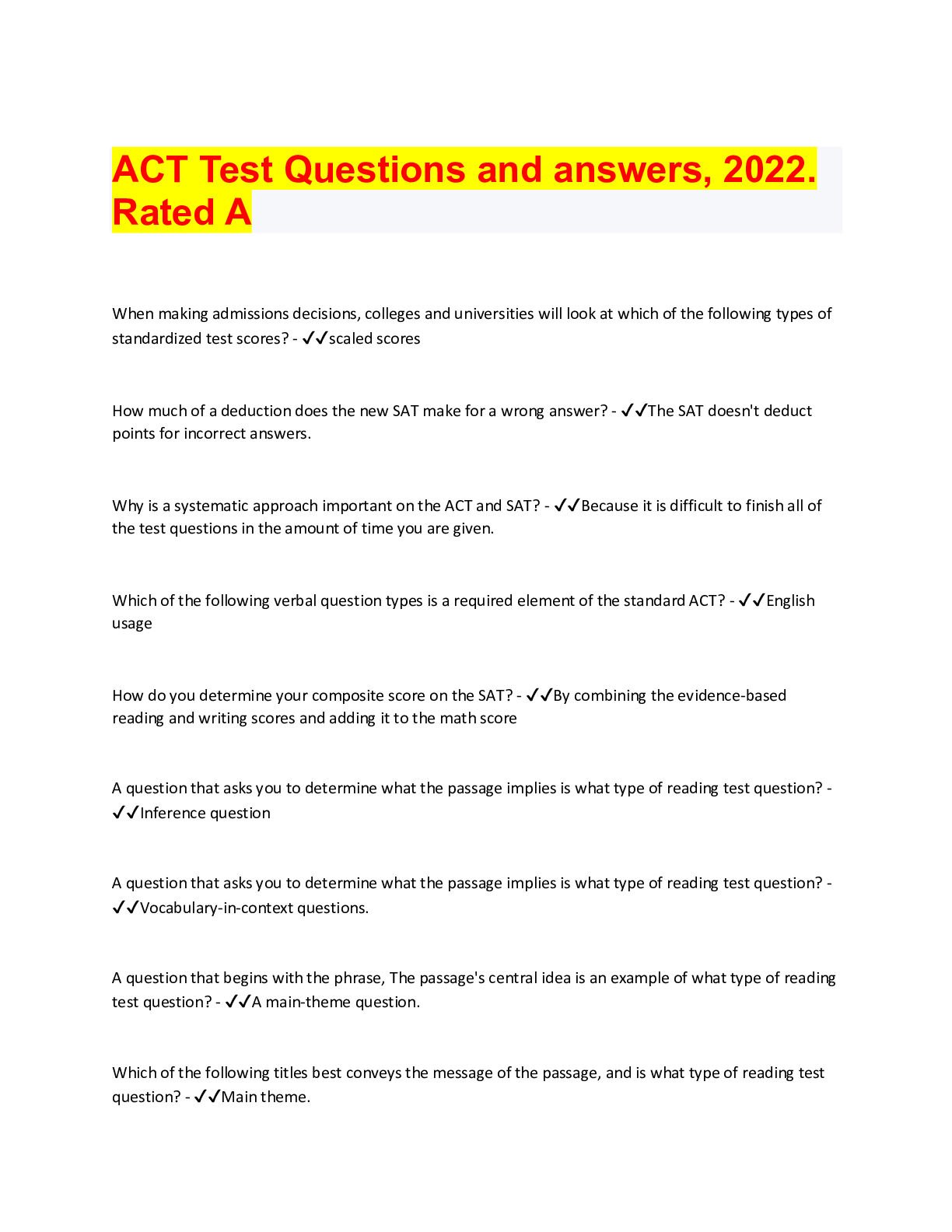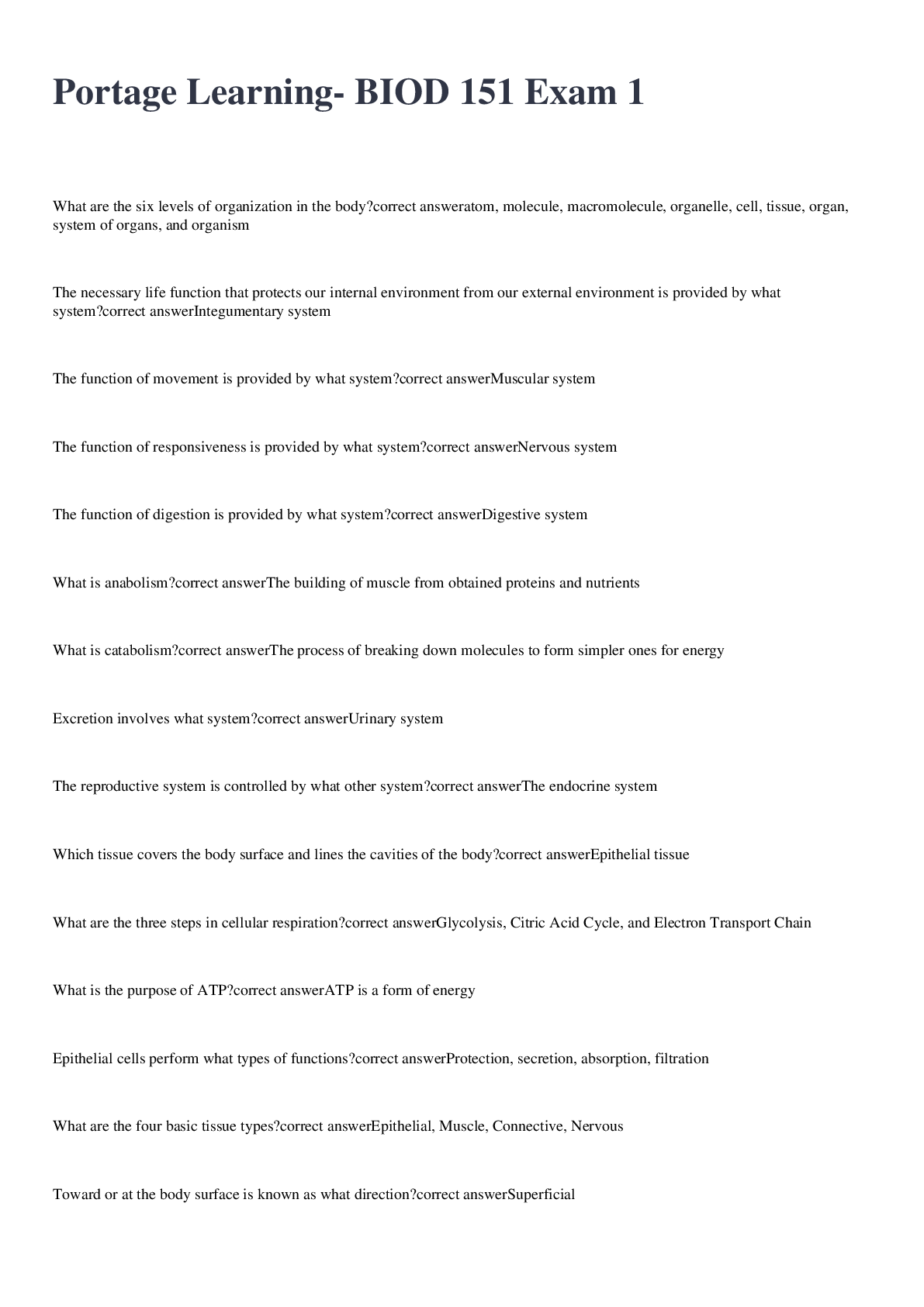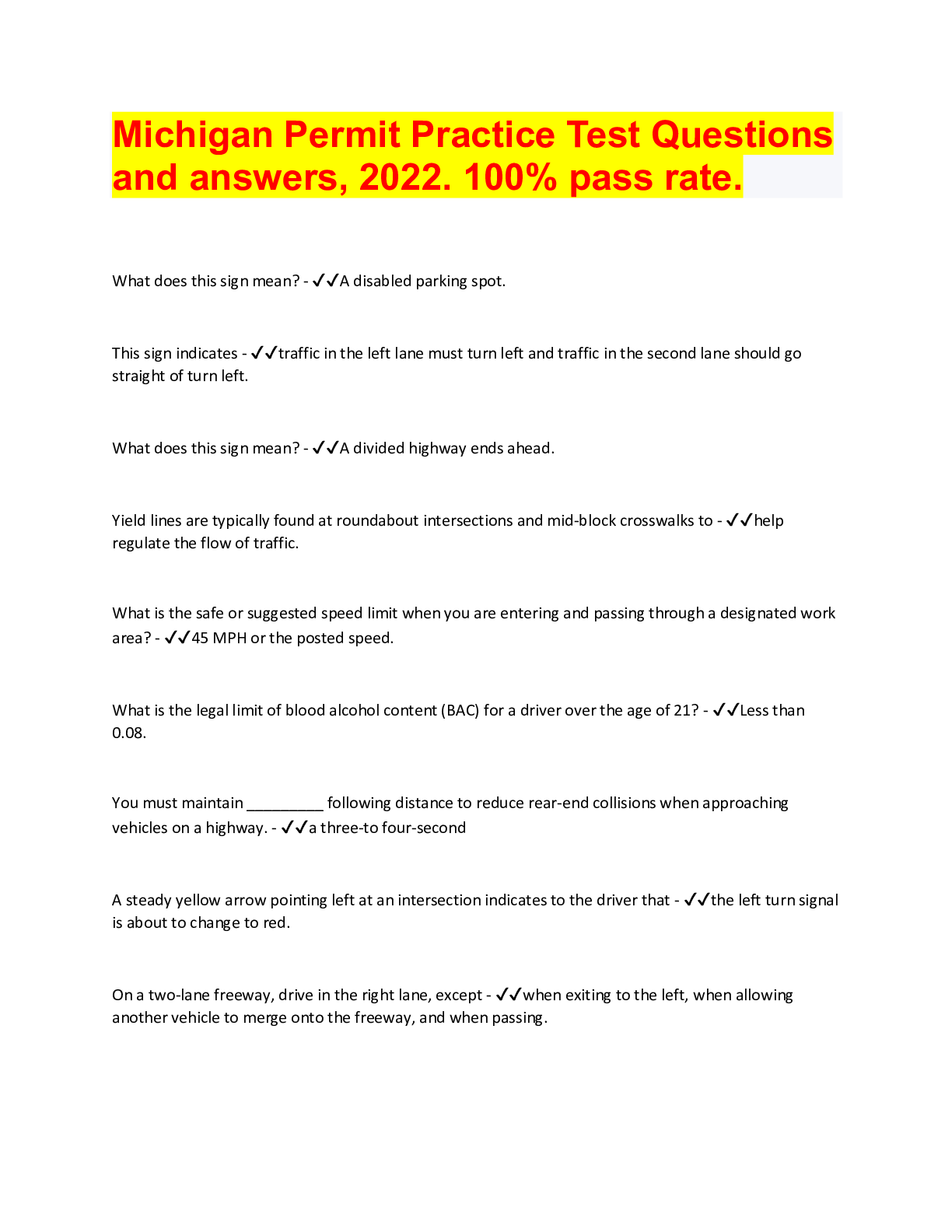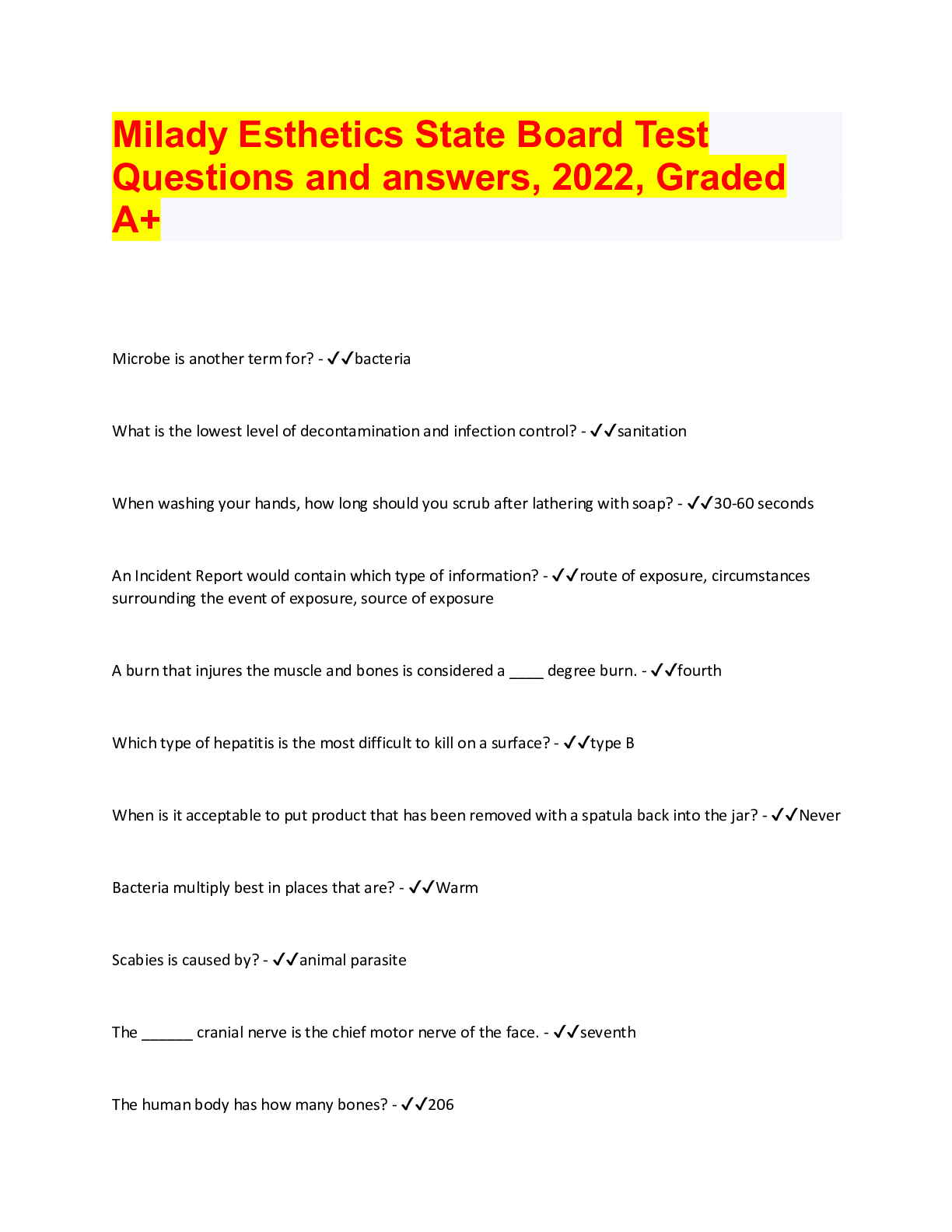*NURSING > QUESTIONS & ANSWERS > pharm Questions and answers, 2022 update, Graded A TEST BANK. (All)
pharm Questions and answers, 2022 update, Graded A TEST BANK.
Document Content and Description Below
pharm Questions and answers, 2022 update, Graded A TEST BANK. The nurse is teaching a client with an ankle sprain about the drug ibuprofen (Advil). What should be included in the teaching? - �... �✔Report any unusual bruising to the health care provider. Avoid the use of alcohol while taking ibuprofen. Do not take aspirin and ibuprofen together. Use sunscreen and protective clothing when outdoors. The pediatric nurse is assessing a child in the clinic who has tested positive for an influenza virus. Assessment vital signs reveal a temperature of 102.4°F (39.4°C). Which medication does the nurse anticipate will be ordered for the client? Select all that apply. - ✔✔Ibuprofen (advil) acetaminophen (tylenol) The nurse on a surgical unit is assessing the incision of a client who underwent an exploratory laparotomy. Which incision description indicates a normal inflammatory response? Pink skin, separation, and pain Drainage, pallor, and pain Odor, necrosis, and hot to touch Redness, edema, and warmth to touch - ✔✔Redness, edema, and warmth to touch The nurse is reviewing the use of acetylsalicyclic acid (aspirin [Bayer]) in the client population. Which clients could benefit from the use A client with mild back pain after a fall An adult client with a fever A client with inflammatory arthritis . A client with gastrointestinal bleeding A client with primary dysmenorrhea - ✔✔A client with mild back pain after a fall An adult client with a fever A client with inflammatory arthritis A client with primary dysmenorrhea The nurse is assessing a client with tonsillitis. The client asks the nurse why the tissues in the neck seem swollen. Which nursing response is best? "Your lymph nodes and tissues sometimes swell in attempts to fight infection." "The swelling is a direct effect of histamine being released throughout the body." "T cells are activated in the neck area, which causes the neck to swell." "The neck area contains proteins that collect and cause the swelling." - ✔✔"Your lymph nodes and tissues sometimes swell in attempts to fight infection." The nurse is reviewing the orders of a client admitted with a diagnosis of gastrointestinal (GI) bleeding. Which order would the nurse question? - ✔✔Ibuprofen (Advil) 200 mg, 2 tablets PO every 6 hours as needed for pain Arrange the steps of an initial acute inflammatory response in the correct order. - ✔✔1. pathogen invades 2. chemical mediators are released 3. nearby blood vessels dilate 4. capillaries become permeable 5. proteins enter affected area 6. pathogen is destroyed 7. damage is repaired Which nonspecific body defenses are considered the first line against infection? Select all that apply. Cilia Phagocytes Lymph node Mucous membranes Skin - ✔✔Cilia Phagocytes Mucous membranes Which signs are associated with aspirin (Bayer) toxicity? Select all that apply. Tinnitus Decreased hearing Stomach discomfort Inflammation of joints Blood clots - ✔✔tinnitus decreased hearing stomach discomfort Identify the type of immune response based on the description. cell-mediated immune response OR humoral immune response? t cells produce cytokines b lymphocytes become plasma cells cytokines kill antigens plasma cells produce immunoglobulins t lymphocytes are cloned b cells are cloned cytokines strength macrophages ANTIbodies code antigens for elimination - ✔✔Type Description Cell-Mediated Immune Response T cells produce cytokines Humoral Immune Response B lymphocytes become plasma cells Cell-Mediated Immune Response Cytokines kill antigens Humoral Immune Response Plasma cells produce immunoglobulins Cell-Mediated Immune Response T lymphocytes are cloned Humoral Immune Response B cells are cloned Cell-Mediated Immune Response Cytokines strengthen macrophages Humoral Immune Response Antibodies code antigens for elimination When administering a recommended dose of acetaminophen (Tylenol) to an adult client, what results can you expect? Reduction of pain Few adverse effects No progression of inflammation Reduction of inflammation Reduction of fever - ✔✔reduction of PAIN few adverse effects reduction of FEVER Prostaglandins provide several beneficial effects. Which beneficial effects are reduced when aspirin (Bayer) is used? Select all that apply. Protection from stomach acid Blood flow to the kidneys Clotting of blood Reduction of inflammation Maintenance of bronchial smooth muscle - ✔✔Maintenance of bronchial smooth muscle Protection from stomach acid Blood flow to the kidneys Clotting of blood Which anti-inflammatory drug inhibits only one type of cyclooxygenase? Ecotrin Nuprin Motrin Celebrex - ✔✔celebrex What instructions should you give to a client who is taking enteric-coated aspirin? Select all that apply. Take with 240 mL of water or milk. Avoid alcoholic beverages. Stop medication 2 days before dental work. Report pregnancy. Do not crush or chew the medication. - ✔✔Avoid alcoholic beverages. Report pregnancy. Do not crush or chew the medication. What is the most common physical issue related to Nonsteroidal Antiinflammatory Drug (NSAID) therapy that the nurse should assess for before and during administration? Migraine Gastrointestinal (GI) bleeding Autoimmune disorder Dysrhythmia - ✔✔Gastrointestinal (GI) bleeding Rosa Dillon, a 10-year-old client, is in the hospital following a car accident. She has sustained two broken ribs, along with cuts and bruises. As you clean and dress her wounds, Rosa worries because they are so swollen. As her nurse, what should you do to address Rosa's concerns? Assess for relief of symptoms. Explain how inflammation helps her body heal. Explain to her how the lymphatic system works. Consult with her admitting nurse. - ✔✔Explain how inflammation helps her body heal. Tommy Powell and his mother have come to your clinic. Tommy is a 6-year-old who presents with symptoms of chickenpox. What is the drug of choice for controlling Tommy's fever and pain? Aspirin (Bayer) Celecoxib (Celebrex Acetaminophen (Tylenol) Morphine sulfate (Duramorph) - ✔✔Acetaminophen (Tylenol) Your client, Mrs. Valya Nelson, has been taking celecoxib (Celebrex) for three years for rheumatoid arthritis. She recently self-medicated with 800 mg of ibuprofen (Advil) twice a day for pain. Mrs. Nelson reports being chronically tired. Her eyes and skin are jaundiced. What adverse effect do you suspect? Kidney disease Low potassium Liver dysfunction High cholesterol - ✔✔Liver dysfunction A client admitted with gastric discomfort and peptic ulcer disease has a temperature of 102.8°F (39.65°C). Which ordered medication does the nurse select to administer? Acetylsalicylic acid (aspirin) Ketoprofen (Orudis) Acetaminophen (Tylenol) Ibuprofen (Advil) - ✔✔Acetaminophen (Tylenol) TYLENOL DOES NOT CAUSE GASTRIC IRRITATION OR BLEEDING The nurse on the orthopedic unit is caring for a client with bone infection secondary to an open fracture of the right leg. The client was found in a field following a tornado injury. Which best explains the cause of the infection? The introduction of bacteria when the dressings were changed Inadequate nutrition to boost immunity The orthopedic surgeon's lack of sterility when treating the fracture The break in the skin caused by the open-fracture injury - ✔✔The break in the skin caused by the open-fracture injury The nurse is assessing a recently admitted male client who has osteoarthritis and hypertension. The record indicates that the client has been taking high-dose aspirin. Which client comment causes the nurse the most concern? Click the three Exhibit links below for additional information about the client. EXHIBIT Vital Signs LOADING... Home Medications LOADING... Testing LOADING... "I need to speak with the doctor when he arrives." "I have been having trouble hearing for the past 2 weeks." "My arthritis makes me stiff, especially in the morning." "I usually take my scheduled medication with food." - ✔✔"I have been having trouble hearing for the past 2 weeks." THIS IS AN ADVERSE EFFECT The nurse is caring for a child with pneumonia and fever of 100°F (38.1°C). The child's parent asks the nurse, "Why doesn't the doctor have something ordered for the temperature before it gets to 101 degrees?" Which is the nurse's best response? "Your doctor does not want to give your child unnecessary medication." "A little fever is not going to hurt your child." "A low-grade fever can aid in defense and repair of the body." "Don't worry. We will not let your child's temperature get too high." - ✔✔"A low-grade fever can aid in defense and repair of the body." A client with arthritis has been prescribed acetylsalicylic acid (aspirin [Bayer]). Which information should the nurse teach the client about the drug? Select all that apply. Swallow the aspirin with a full glass of water, milk, or food. Use ear plugs for ringing in the ears. Avoid using alcohol while taking aspirin. Expect black stools as a side effect. Stop using aspirin 7 to 14 days prior to any scheduled surgery. - ✔✔Swallow the aspirin with a full glass of water, milk, or food. Avoid using alcohol while taking aspirin. Stop using aspirin 7 to 14 days prior to any scheduled surgery. RATIONALE: Aspirin should be administered with adequate amounts of water, milk, or food to decrease the incidence of gastrointestinal irritation. Aspirin should be stopped prior to surgery and dental work to decrease the chance of excessive bleeding. Alcohol combined with aspirin increases the chance of stomach irritation. Any ringing in the ears or difficulty with hearing should be reported to the health care provider for possible intervention. Black, tarry stools are an adverse effect of aspirin and should be reported to the health care provider, because they could indicate bleeding in the gastrointestinal tract. The nurse is assessing a client with abdominal pain and a history of daily nonsteroidal antiinflammatory drug (NSAID) use for 6 months. Which assessment finding causes the nurse the most concern? Nausea related to the intake of food Dry mucous membranes in the oral cavity Bright red blood in the stools Pain in the epigastric area of the abdomen - ✔✔Bright red blood in the stools rationale: could have an active bleed in the GI tract The nurse is assessing the skin of a newly admitted 70-year-old client when a rash is noted on the trunk of the body. What condition, caused by a virus but preventable by vaccination, does the nurse suspect? Psoriasis Rheumatoid arthritis Shingles Atopic dermatitis - ✔✔Shingles The nurse is reviewing the pathophysiology of the immune system. Which condition may occur in clients who have continual secretion of the immune response chemicals? Diabetes Peptic ulcers Hypertension Rheumatoid arthritis - ✔✔Rheumatoid arthritis When administering a vaccination to a client, what should the nurse consider? Select all that apply. Route of administration Anaphylaxis and adverse reactions Precautions and contraindications Time of last food intake Dose and timing - ✔✔Route of administration Anaphylaxis and adverse reactions Precautions and contraindications Dose and timing The nurse is reviewing a hospital memo regarding the proper storage of monoclonal antibodies. Which drugs should be stored under the conditions prescribed in the memo? Select all that apply. Daclizumab (Zenapax) Muromonab-CD3 (Orthoclone OKT3) Mycophenolate mofetil (CellCept) Thalidomide (Thalomid) Basiliximab (Simulect) - ✔✔Daclizumab (Zenapax) Muromonab-CD3 (Orthoclone OKT3) Basiliximab (Simulect) Rationale Basiliximab (Simulect) is a monoclonal antibody and a preventive for kidney transplant rejection. Daclizumab (Zenapax) is classified as an MAB and has immunosuppressant properties. Mycophenolate mofetil (CellCept) is not classified as an MAB, but it can be given to prevent heart, kidney, and liver transplant rejection. Thalidomide (Thalomid) is not a MAB; it is used to treat leprosy and refractory Crohn's disease. Muromonab-CD3 (Orthoclone OKT3) is an MAB that is given to prevent kidney transplant rejection and is administered by the IV route. The nurse is preparing a presentation for a group of newly hired nurses to give an overview of immunostimulants and the immune response system. Which points would the nurse include in the presentation? Select all that apply. Cytokines are the chemicals that help facilitate the body's immune response. Immunomodulators are drugs that increase the immune response in the body. T-cell lymphocytes are responsible for creating antibodies, used in the development of long-term immunity against antigens. The immune response protects the body against invading organisms or agents. B-cell lymphocytes regulate the body's immune response by releasing cytokines. - ✔✔Cytokines are the chemicals that help facilitate the body's immune response. Immunomodulators are drugs that increase the immune response in the body. The immune response protects the body against invading organisms or agents. The nurse is caring for a client after a kidney transplant. Which drug does the nurse expect to administer to prevent rejection of the kidney? Cyclophosphamide (Cytoxan) Cyclosporine (Neoral, Sandimmune) Methotrexate sodium (Rheumatrex) Etanercept (Enbrel) - ✔✔Cyclosporine (Neoral, Sandimmune) RATIONALE: cyclosporine is given to prevent kidney, liver, and heart transplant rejection What "triggers" an immune system response? Redness/swelling at an injury site Fever Antibody entering the body Antigen entering the body - ✔✔Antigen entering the body When the immune system chronically produces cytokines, what autoimmune conditions may result? Select all that apply. Malignant melanoma Psoriasis Rheumatoid arthritis Hepatitis C Crohn disease - ✔✔Psoriasis Rheumatoid arthritis Crohn disease If a client has a fever, why may immunostimulant drug therapy have to be delayed? Select all that apply. Fever indicates the need for intravenous antibiotics to be added to the prescribed therapy. Fever puts the client more at risk for drug adverse effects. Fever makes it harder to distinguish adverse effects of drug therapy from effects of the infection. Fever indicates the need to choose a different medication regimen. Fever increases the needed duration of immunostimulant drug therapy. - ✔✔Fever puts the client more at risk for drug adverse effects. Fever makes it harder to distinguish adverse effects of drug therapy from effects of the infection. Identify the class of immunosuppressants based on the drug name. Immunosuppressant Drug Name Cytotoxic Agents and Antimetabolites Azathioprine (Azasan) Calcineurin Inhibitors Cyclosporine (Neoral) Monoclonal Antibodies Muromonab-CD3 (Orthoclone OKT3) Calcineurin Inhibitors Tacrolimus (Program) Cytotoxic Agents and Antimetabolites Mycophenolate mofetil (CellCept) Monoclonal Antibodies Basiliximab (Simulect) - ✔✔ Which category of immunosuppressants is developed by first injecting human T cells, B cells, or thymocytes into animals? Antimetabolites Cytotoxic agents Calcineurin inhibitors Monoclonal antibodies - ✔✔Monoclonal antibodies Which immunosuppressants are used to treat rheumatoid arthritis? Select all that apply. Etanercept (Enbrel) Anakinra (Kineret) Thalidomide (Thalomid) Methotrexate sodium (Trexall) Interferon alfacon-1 (Infergen) - ✔✔Etanercept (Enbrel) Anakinra (Kineret) Methotrexate sodium (Trexall) When vaccinations are administered to prevent disease, what is the result called? Active immunity Immunoactivation Immunosuppression Passive immunity - ✔✔Active immunity Identify the category of immunizing agent for each condition. Instructions: Use the dropdown menus in the left column to select the correct category of immunizing agent for each condition in the right column. - ✔✔Category Condition Immunoglobulins Gammigard Inactive Bacterial Toxins Diphtheria Viral Vaccines Hepatitis A Inactive Bacterial Toxins Pneumococcus Immunoglobulins CytoGam Inactive Bacterial Toxins Pertussis Viral Vaccines Influenza Inactive Bacterial Toxins Tetanus Immunoglobulins Nabi-HB Viral Vaccines Measles Immunoglobulins HyperHep Viral Vaccines Rabies What are the most common routes of administration for immunizing agents? Select all that apply. Subcutaneous Rectal Sublingual Intranasal Deltoid injection - ✔✔Intranasal Deltoid injection Subcutaneous Melanie Baxter is a 56-year-old client who is being treated in your clinic for chronic hepatitis C. Ms. Baxter asks why she is prescribed interferon alfa-2b (Intron A) for hepatitis when this drug is used to treat different types of cancer. What is your best response? Because clinical manifestations of hepatitis C mimic those of a malignancy, hepatitis C responds well to interferon alfa-2b (Intron A). Interferon alfa-2b (Intron A) has a broad range of actions that help the immune system better fight both cancers and viruses. Interferon alfa-2b (Intron A) was prescribed to prevent the development of a malignancy related to hepatitis C, not to treat the hepatitis. Interferon alfa-2b (Intron A) is not used to treat hepatitis C, so you should consult your health care provider to discuss the error. - ✔✔Interferon alfa-2b (Intron A) has a broad range of actions that help the immune system better fight both cancers and viruses. When Ms. Baxter asks how often she will need to take interferon alfa-2b (Intron A), what should your response be? Once a week Once a day Three times per week Once every other week - ✔✔Three times per week Hwong Li, who had a kidney transplant, is prescribed azathioprine (Imuran). He asks how this medication works and why he needs to take it. You explain that azathioprine is what? A corticosteroid used to suppress the immune system and minimize transplanted tissue rejection An antimetabolite used to prevent the body's rejection of transplanted tissue by suppressing T-cell effects An antibiotic used to prevent infection in transplanted tissue A chemotherapeutic agent used to improve blood supply to a newly transplanted organ - ✔✔An antimetabolite used to prevent the body's rejection of transplanted tissue by suppressing T-cell effects Mr. Li asks if there is anything that he needs to be aware of while taking azathioprine (Imuran). As the nurse, what do you recognize as one of the most important clinical manifestations to watch for? Signs and symptoms of any infection Raised, red rash on the torso Development of progressive tooth decay Progressive muscle weakness - ✔✔Signs and symptoms of any infection Your answer is correct. Cheryl Jones brings her 6-month-old infant to your clinic for a well-child checkup and immunizations. Mrs. Jones asks if the baby will have any side effects from the immunizations. How should you respond? Many children experience malaise, fever, irritability, and poor appetite. You may see redness and tenderness at the injection site but not a severe systemic response. Adverse effects from immunizations are uncommon. Don't be concerned if your child becomes very sleepy or has labored breathing. - ✔✔Many children experience malaise, fever, irritability, and poor appetite. A client presents to the clinic for a pelvic exam. The nurse notes multiple genital warts when preparing the client for the exam. Which medication does the nurse anticipate the health care provider will prescribe? Interferon alfa-n3 (Alferon N) Interferon beta-1a (Avonex) Interferon alfacon-1 (Infergen) Peginterferon alfa-2b (PEG-Intron) - ✔✔Interferon alfa-n3 (Alferon N) Rationale Interferon alfa-n3 (Alferon N) is an interferon that has antiviral, antineoplastic, and anti-inflammatory actions; it is used to treat genital warts. Interferon beta-1a (Avonex) is an interferon used for multiple sclerosis. Peginterferon alfa-2b (PEG-Intron) is an interferon used for chronic hepatitis B or C. Interferon alfacon-1 (Infergen) is an interferon used for chronic hepatitis C. The nurse is preparing a teaching plan for administering immunizing agents. What should the nurse include as teaching points for clients or caregivers? Select all that apply. Be aware of common side effects of the vaccine. Report a temperature over 103degrees°F (39.4degrees°C). Comply with the vaccination schedule. Expect a change in mental status after administering a vaccine. A mild pain reliever to minimize pain or other discomforts may be administered. - ✔✔Be aware of common side effects of the vaccine. Report a temperature over 103degrees°F (39.4degrees°C). Comply with the vaccination schedule. A mild pain reliever to minimize pain or other discomforts may be administered. The nurse is observing a student who is administering medications. Which action requires intervention by the nurse? Instructing a client that the student will be giving methotrexate (Rheumatrex) intramuscularly (IM) as ordered Drawing up etanercept (Enbrel) to administer intramuscularly (IM) Preparing to administer anakinra (Kineret) subcutaneously (SC) Preparing to administer azathioprine (Azasan) intravenously (IV) - ✔✔Drawing up etanercept (Enbrel) to administer intramuscularly (IM) Etanercept (Enbrel) is given subcutaneously; the nurse would need to intervene to prevent an error in administration of the drug if the student drew it up for IM injection. The student is acting correctly in administering anakinra (Kineret) SC, giving azathioprine (Azasan) IV or PO, and administering methotrexate (Rheumatrex) IM; the nurse need not to intervene in these instances. The nurse is providing discharge teaching to a client prescribed steroids for long-term use. Which adverse effects should the nurse include in the discussion? Select all that apply. Changes in mental status Hypotension Porous bones (osteoporosis) Obesity Cataracts - ✔✔Changes in mental status Porous bones (osteoporosis) Obesity Cataracts A client is seen in the clinic after receiving a vaccination. Which reported clinical manifestation causes the nurse the most concern? Loss of appetite Irritability Malaise Confusion - ✔✔Confusion A client on the oncology unit has received the drug filgrastim (Neupogen). The nurse is reviewing the laboratory reports. Which laboratory value indicates that the drug has been effective? White blood cells (WBCs) 5500 µL (normal: 4500 to 10,000) Hemoglobin 14 g/dL (normal: 13.5dash-18 g/dL) Hematocrit 38% (normal: 40%dash-54%) Potassium 3.5 mEq/L (normal: 3.5 mEq/Ldash-5.5 mEq) - ✔✔White blood cells (WBCs) 5500 µL (normal: 4500 to 10,000) The nurse is caring for a client with a treated wound. What would the nurse be looking for as she assesses the wound? How the wound is immobilized Redness and swelling Location and extent of tissue damage A foreign object - ✔✔Redness and swelling This is the correct answer. The nurse assesses the skin of a newly admitted client. Findings include a 3 cm area with partial thickness dermis loss on the client's sacral area. Which documentation is an accurate description of the assessment? A stage IV ulceration 3 cm on sacral area 3 cm stage II pressure ulcer sacral area A stage I ulcer 3 cm in diameter on sacral region Stage III pressure ulcer noted on sacrum - ✔✔3 cm stage II pressure ulcer sacral area The nurse is reviewing the record of a client who is at risk for skin breakdown. Which lab data would be of particular concern to the nurse who is concerned with skin integrity? Leukocyte level of 6,000 Potassium level of 4.0 mEq/L Hemoglobin level of 10.2 g/dL Albumin level of 4.0 g/dL - ✔✔Hemoglobin level of 10.2 g/dL The nurse sees a health care provider order to apply a hydrocolloid dressing to a client with an infected pressure ulcer. Which is the most appropriate nursing action? Apply a transparent dressing to the area instead of the hydrocolloid. Implement the dressing change procedure as ordered. Question the health care provider's order. Administer pain medication prior to applying the hydrocolloid dressing. - ✔✔Question the health care provider's order. A nurse is evaluating skin care needs. Which client poses the greatest risk for skin breakdown? A 36-year-old with coronary artery disease An 18-month-old with bronchitis A 20-year-old with a urinary tract infection A 74-year-old with a diagnosis of diabetes - ✔✔A 74-year-old with a diagnosis of diabetes The nurse is developing a care plan to prevent skin breakdown. Which body fluid does the nurse recognize as the least likely to cause skin excoriation? Excessive saliva Gastric juices Perspiration Tears - ✔✔Tears The orthopedic nurse educator is preparing a post-conference seminar on osteomyelitis for a group of nurses. Which client is identified to have the greatest risk of developing this condition? 60-year-old with full-thickness tissue loss and subcutaneous fat visible 35-year-old paraplegic with tissue loss extending through the muscle 22-year-old with gastroenteritis and redness in the perianal area 50-year-old with paralysis and redness on the sacrum - ✔✔35-year-old paraplegic with tissue loss extending through the muscle The nurse has performed client teaching on how to cleanse a wound. Which statement by the client indicates further instruction is necessary? "I should cleanse the wound with a cotton pad." "If the wound appears clean, I will not have to clean it each time I change the dressing." "I should clean in an outward direction." "I should avoid drying the wound after I clean it." - ✔✔"I should cleanse the wound with a cotton pad." Ms. Peterson has slid down toward the foot of her bed and is unable to move herself back up in the bed. You call the nursing assistant to help you move her back up to the top of the bed. If you try to move Ms. Peterson by yourself, you will slide her body up, and her body weight (and moisture on the skin) will cause the skin on her sacrum to stick to the linens and not move while the underlying tissues and muscles do move. This movement may cause _________ on her sacrum and deep tissues. Pressure An abrasion Friction Shearing force - ✔✔Shearing force Ms. Wilson is too weak to move herself in bed; she is immobile. Why is immobility a dangerous condition? Immobility causes damage to blood vessels and deep tissues in those areas that adhere to the bed linens. Her skin and underlying tissues may become compressed over time, especially between a bone and the skin surface. Immobility causes pressure on skin surfaces, leading to poor circulation and oxygenation of tissues, and eventually to skin breakdown (ulceration). Because she has little body fat, the pressure of her weight may cause ulcers to develop on bony prominences. - ✔✔Immobility causes pressure on skin surfaces, leading to poor circulation and oxygenation of tissues, and eventually to skin breakdown (ulceration). Mr. Thompson, a 53-year-old African American client with chronic uncontrolled hypertension, was admitted to the hospital after a massive stroke, which has left him immobile and unable to complete any activities of daily living (ADLs) (e.g. eating, bathing, toileting, transferring) independently. Which of the following are critical components of the assessments the nurse will complete on Mr. Thompson? Select all that apply. Mental status and his ability to report pain or discomfort His ability to independently move from the bed to the chair or to the wheelchair Continence (fecal and urinary) Skin integrity, especially over bony prominences and common pressure areas Level of nutrition and intake of protein, carbohydrates, fluids, vitamins, and other nutrition-related issues - ✔✔Continence (fecal and urinary) Skin integrity, especially over bony prominences and common pressure areas Level of nutrition and intake of protein, carbohydrates, fluids, vitamins, and other nutrition-related issues Mental status and his ability to report pain or discomfort Mr. Johnson, an 89-year-old male, lives with his daughter and her family. Which of the following changes commonly associated with aging, if present in Mr. Johnson, may indicate a greater risk for skin breakdown? Select all that apply. Thinning of the epidermis and decreased skin elasticity Digestive and metabolic issues (the prevalence of gastrointestinal problems rises with age) Changes in hearing (50% of those 85 and older have hearing loss) Decreased pain sensation Loss of lean body mass and a decrease in venous and arterial blood flow - ✔✔Thinning of the epidermis and decreased skin elasticity Decreased pain sensation Loss of lean body mass and a decrease in venous and arterial blood flow Ms. Glenn, a 23-year-old female, was riding with her parents in their car when she was 5 years old. During a collision, she was not restrained in a child seat and went through the windshield in the impact. She has been a paraplegic since the accident. She has suffered only a few pressure ulcers on her coccyx over the past 17 years because she knows what to look for and what are considered preulcer signs and symptoms. Sort the following characteristics of pressure ulcers according to the stage in which they belong. - ✔✔Stage of Ulcer Characteristics Stage I Pressure Ulcer Red area warmer or cooler than surrounding skin Stage II Pressure Ulcer May have intact or ruptured serum-filled blister Stage III Pressure Ulcer May have slough Stage IV Pressure Ulcer Full thickness tissue loss with exposed bone Stage I Pressure Ulcer Skin firm Stage II Pressure Ulcer No slough or bruising Stage III Pressure Ulcer Subcutaneous fat may be visible Stage I Pressure Ulcer Most commonly localized over bony prominences Stage II Pressure Ulcer Presents with red?pink wound bed Stage III Pressure Ulcer May have slough Stage IV Pressure Ulcer Slough or eschar present Stage I Pressure Ulcer Skin intact Stage II Pressure Ulcer Partial thickness loss of dermis Stage III Pressure Ulcer Full thickness tissue loss, bone not exposed Stage I Pressure Ulcer May have pain on palpation Stage II Pressure Ulcer Presents as shallow, open ulcer Stage IV Pressure Ulcer Bone, tendon, and/or muscle exposed Stage I Pressure Ulcer Skin reddened, does not blanch Stage II Pressure Ulcer May appear as shiny or dry shallow ulcer Stage IV Pressure Ulcer Extends into muscle and/or supporting structures Ms. Glenn has a wound and quickly identifies what is happening with her skin. Sort the following examples and characteristics of the three different types of healing patterns. - ✔✔Type of Healing Characteristics Primary Intention Healing Minimal scarring Secondary Intention Healing Longest healing time Tertiary Intention Healing May have unresolved edema or infection Primary Intention Healing Wound closed with tissue adhesive Secondary Intention Healing Greatest scarring Tertiary Intention Healing Wound left open for 3 to 5 days Primary Intention Healing Minimal or no tissue loss Secondary Intention Healing Healing of pressure ulcer Tertiary Intention Healing Surgical wound left open to drain abscess Primary Intention Healing Minimal granulation tissue Secondary Intention Healing More susceptible to infection Primary Intention Healing Tissue surfaces approximated Tertiary Intention Healing Wound closed with sutures or staples Primary Intention Healing Closed surgical wound Mr. Richards, a 51-year-old client who is confined to a wheelchair, has a large wound on his sacrum with full thickness tissue loss; bone, tendons, and muscle are exposed; eschar is present on the lower half and proximal edges of the wound. What stage is this ulcer? [Show More]
Last updated: 1 year ago
Preview 1 out of 149 pages

Buy this document to get the full access instantly
Instant Download Access after purchase
Add to cartInstant download
We Accept:

Reviews( 0 )
$12.00
Document information
Connected school, study & course
About the document
Uploaded On
Aug 21, 2022
Number of pages
149
Written in
Additional information
This document has been written for:
Uploaded
Aug 21, 2022
Downloads
0
Views
102












.png)

